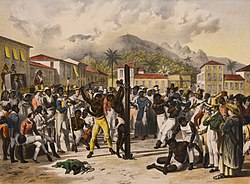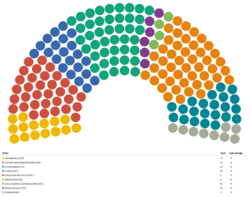Satavia
This article is incomplete because it is pending further input from participants, or it is a work-in-progress by one author. Please comment on this article's talk page to share your input, comments and questions. Note: To contribute to this article, you may need to seek help from the author(s) of this page. |
Republic of Satavia Republiek van Satavia | |
|---|---|
| Location of Satavia, in Green, in Asteria Inferior Location of Satavia, in Green, in Asteria Inferior | |
| Capital and largest city | Hopetown/Hoopstad |
| Official languages | Satavian, Estmerish |
| Recognised national languages | Ma'swa, Tuz'wahli'an among others |
| Ethnic groups (2015) | By race:
|
| Demonym(s) | Satavian |
| Government | Parliamentary republic |
• Governor | Lord Ashpoint |
| Jonty Elliot | |
| Legislature | Parlement Satavianen |
| Provinciale Rechtbank | |
| Volksrechtbank | |
| Establishment | |
• Colonisation by Hennehouwe | March 1677 (c.) |
• Transferal to Estmere | 17th August 1747 |
• Home Rule | 1816 |
• Independence | 31st December 1899, at 23:59 |
| Population | |
• 2018 estimate | 21,501,500 |
• 2015 census | 21,499,000 |
| GDP (nominal) | 2015 estimate |
• Total | $462.2 Billion |
• Per capita | $21,500 |
| Gini (2015) | high |
| HDI (2015) | 0.661 medium |
| Currency | Satavian Guilders (SAT) |
| Time zone | UTC+ 11 (Satavian Standard Time (DST Not Observed)) |
| Date format | dd.mm.yyyy |
| Driving side | left |
| Calling code | +47 |
| Internet TLD | .sa |
Satavia, officially the Republic of Satavia (Satavian: Republiek van Satavia) is an island nation off the coast of Nuvania, located in Asteria Inferior. Satavia shares no land borders with any other recognised countries, but shares a Maritime Border with Nuvania. The Capital and Largest City is Hopetown, also called Hoopstad in Satavian. The Country has two official languages: Estmerish and Satavian, a creole largely consisting of Estmerish and Hennish. One of the country's two largest industry is Viticulture, commonly called 'Wine Growing'. Specifically, Cabernet Sauvignon and Malbec are the most common grapes grown, as the country's climate accomodates the grape's perfectly. The Sheep and Cattle rearing industry are also a prominent part of the Country's economy. Satavia is a member of the inter-governmental organisation ASTCOM.
According to the Community of Nations, Satavia is one of, if not, the most corrupt democracy in Asteria Inferior, and the wider world. Internal unrest is common, with the last major armed uprising being the Monarchist Revolt, which evolved into the Satavian Civil War.
Following the 2020 General Election, the pro-monarchist Conservative Party gained a majority in the Parlement Satavianen.
Etymology
'Satavia', or in it's native form 'Sátiva', a given name from the Muisca Peoples, also refered to as the 'Muisca Tribe'. Post independence, the newly-elected government, lead by Sir Cecil Browning, wishing to distance itself from the colonial name of the 'Hope Colony', and later, the 'Dominion of Hope', chose to adopt a new name. The previous name, 'Hope' came from the Hennish 'Hoop', derivating from the 'River Hope', or in Satavian 'Rivier Hoop'.
History (Under Re-Construction)
Pre-Historic
Pre-Eucelan
Hennish Colonisation (Under Re-Construction)
At some time around March 1677, the Hennish explorer and poet, Jan van Breyetenbach, landed at the mouth of the River Hope. Van Breytenbach established the settlement of 'Hoopstad'. During September of that year, van Breytenbach was officially appointed 'Gouverneur van de Hoop Kolonie', or in Estmerish, 'Governor of the Hope Colony'. The colony was plagued by difficulty to begin with - a lack of sanitation in Hoopstad lead to an outbreak of Dysentery among the settlers. The colony also had trouble with the native population - up until 1679, when Chief Uk'anwa met with Jean de Flaissane, a colonist who arrived from Gaullica with the task of promoting Gaullica's interests in the colony, negotiated a treaty. The Treaty, often erinously refered to as the Treaty of Hoopstad, although actually called the ''Native-Flaissane Agreement'', ended hostilites with natives for the next 150 years.
During the Hennish Administration of the Hoop Kolonie, unrest was common among the settlers, often caused by high taxes and little to no representation. The most infamous revolts included the Farmer Rebellion (1708) and the Ink Revolt (Satavia).
The Hennish colonists imported thousands of slaves from Bahia, and by 1745 there were an estimated 30,000 colonists and a further 10,000 slaves, taken from the coast of Bahia. Compact housing and appauling conditions meant that outbreaks of diseases were commonplace, and would lead to the deaths of hundreds of slaves. The lack of adequate medication meant that many slaves contracted diseases that in practice were curable, but due to the lack of doctors willing to administer what little medication they had to unpaying slaves. This lead the Hoop Kolonie to be known as the 'Slave Abattoir'.
The colony was centered around Hoopstad, and the wider province of Hoop Provincie. The Governor was the representitive of the Monarch in the colony, whilst absoloute power was appointed to the governor, and the Mayor of Hoop Povincie.
During Hennish control, settler's rarely entered the interior. This was due to a fear of upsetting the natives, as agreed by the Native-Flaissane Agreement.
Hennish control over the Hoop Kolonie ended following the Estmerish-Hennish war of 1747, which saw the transfer of the colony over to Estmere.
Estmerish Period
Home Rule
War of the Arucian
Post-Independence
- To be devided into: Kingdom of Satavia, Republic of Satavia and Satavian Civil War
Periods: The Great Collapse, The Great War, December Coup, White Satavia and Modern Period
Geography
Climate
Historical Impact
Politics (Under Re-Construction)
Satavia has a Left-Right multi-party system. Since the 2016 General Election, the biggest parties in the Volksrechtbank are the center-right Unity Coalition, who itself did not achieve a majority of 100 seats, so formed a coalition with the Centraal (Satavia) party, the second largest party. Since 2017, the coalition has attempted on mulitple occasions to pass a law, known as the Electoral Reform Act (Satavia), which would allow for the creation of up to 150 more seats. This has been blocked by the remaining parties on mulitple occasions.
Government
Prime Minister
Governor
The 'Governor of Satavia' has been an official position since September 1677, when it was appointed to Jan van Breyetenbach. The current Governor is Lord Ashpoint, who is also the leader of the Groep voor de Troon, a royalist party. The Governor was ceremonially appointed by the King of Estmere, until 1936, with the abolishment of the monarchy. Lord Ashpoint and his 'GVDT' party believe in the restoration of an elective monarchy to Satavia.




